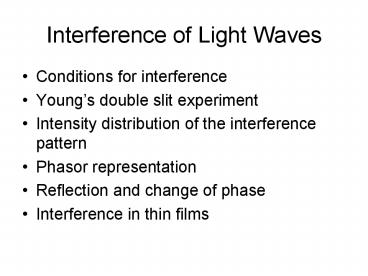Interference of Light Waves PowerPoint PPT Presentation
1 / 20
Title: Interference of Light Waves
1
Interference of Light Waves
- Conditions for interference
- Youngs double slit experiment
- Intensity distribution of the interference
pattern - Phasor representation
- Reflection and change of phase
- Interference in thin films
2
Conditions for Interference
- If two waves have a definite phase relationship
then they are coherent. - Otherwise, they are incoherent (ex two light
bulbs). - For Interference
- The sources must be coherent.
- The sources should be monochromatic.
3
Youngs Double-Slit Experiment
4
Constructive interference
Destructive interference
5
Intensity Distribution of the Interference Pattern
If
then
6
Intensity Distribution of the Interference Pattern
- Interference depends on the relative phase of the
two waves. - It also depends on the path difference between
them. - The resultant intensity at a point is
proportional to the square of the resultant
electric field at that point.
not
7
An interference pattern is formed on a screen by
shining a planar wave on a double- slit
arrangement (left). If we cover one slit with a
glass plate (right), the phases of the two
emerging waves will be different because the
wavelength is shorter in glass than in air. If
the phase difference is 180, how is the
interference pattern, shown left, altered?
1. The pattern vanishes. 2. The bright spots lie
closer together. 3. The bright spots are farther
apart. 4. There are no changes. 5. Bright and
dark spots are interchanged.
8
Phasor Addition of Waves
9
Phasors for Several Waves
- Represent waves by phasors, remembering to
maintain proper phase relationships between them. - The resultant phasor, ER, is the vector sum of
the individual phasors. The phase angle, a, is
the phase angle between ER and the first phasor.
10
Phasors for Two Coherent Sources
11
Three-Slit Interference Pattern
12
Multiple Slit Patterns
13
Change of Phase in Reflection
The positions of the fringes are reversed
compared to Youngs experiment
An EM wave undergoes a phase change of 180 upon
reflection from a medium that has a higher index
of refraction than the one in which it is
traveling.
14
String Analogy
15
Interference in Thin Films
- A wave traveling from a medium of index of
refraction of n1 towards a medium with index of
refraction of n2 undergoes a 180 phase change
upon reflection if n2 gt n1 and no phase change if
n2 lt n1. - The wavelength of light ln in a medium with index
of refraction n is given by, ln l / n.
For constructive interference
m 0,1,2,
For destructive interference
m 0,1,2,
16
Two identical slides in air are illuminated with
monochromatic light. The slides are exactly
parallel, and the top slide is moving slowly
upward. What do you see in top view? 1. all
black 2. all bright 3. fringes moving apart 4.
sequentially all black, then all bright 5. none
of the above
17
Newtons Rings
For destructive interference
For constructive interference
18
Non-reflective Coatings
Since both paths have the same phase change at
the interfaces, take only the path differences
into account.
For destructive interference
t
Example l 550 nm, no reflection
19
Monochromatic light shines on a pair of identical
glass microscope slides that form a very narrow
wedge. The top surface of the upper slide and the
bottom surface of the lower slide have special
coatings on them so that they reflect no light.
The inner two surfaces (A and B) have nonzero
reflectivities.
A top view of the slides looks like 1. I. 2. II.
20
Interference in a Wedge Shaped Film
Destructive interference at the tip because of
180 phase change for the front surface and no
phase change for the back surface.
For destructive interference
For constructive interference

